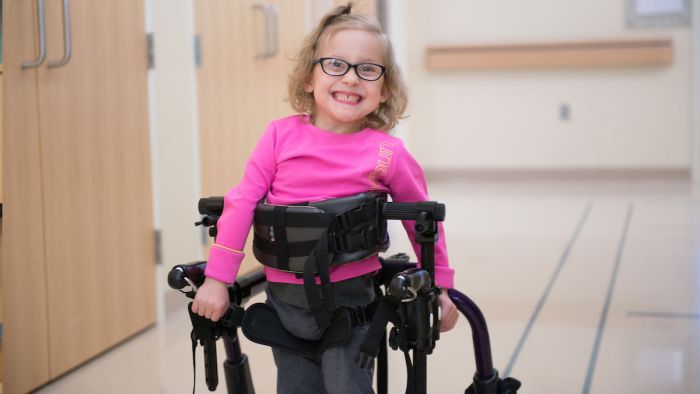Dynamic Motor Control Found to Be Vital in Assessing Treatment Efficacy in Cerebral Palsy
Two new studies surrounding dynamic motor control could mean big changes in the treatment of cerebral palsy (CP). At the heart of this innovative work lies a new measure of physical ability known as dynamic motor control during walking (walk-DMC, or DMC for short).
The Difference Is Dynamic
Providers can easily test static motor control during a physical exam, asking a patient to move their leg one way or another. Those are good measures for diagnosing and treating symptoms like motor delays. Dynamic motor control, however, is a measure of a patient’s ability to move their muscles while walking. Neuroscience tells us these are two vastly different measures of neurological function, so how do Gillette providers put DMC evaluation to effective use for patients?
In partnership with Kat Steele, PhD, at the University of Washington, Gillette researcher Michael Schwartz, PhD, has been investigating motor function for more than a decade. Through a study funded by the National Institutes of Health (NIH), Schwartz and Steele brought children in, measured their DMC, followed them through surgery, and looked at their outcomes. “We were able to show that the DMC number had some useful clinical importance,” Schwartz explains. “It was at the center of a lot of the impairments that are present in the patients we see at Gillette. For example, their walking pattern seems to be driven a lot by their DMC. Their energy seems to be significantly driven by this, as well as their walking speed and their ability to do more higher-level functional tasks like climbing stairs, stepping off a curb, or riding on an escalator.”
This fundamental neurophysiological quantity, DMC, was not only an indicator, but the causal factor behind impairment in gait pattern, motor function, and energy consumption. No currently available treatments have a significant impact on the last two of these three outcomes.
“We see patients who have CP trying to manage these factors over and over again, Schwartz says. “Energy consumption is the one thing families reliably bring up without us even asking. So we’ve proven scientifically DMC is an important cause of high energy consumption, and we’re hearing from our families that high energy consumption is a big pain point for them.”
The Future of CP Treatment?
Because Schwartz has recognized how important DMC is to a person’s gait pattern, motor function, and energy consumption, Gillette will continue to investigate ways to improve it in children who have a deficit of dynamic and stationary motor control. Schwartz continues to lead this research with two novel studies.
The first study continues with Steele and pulls in partner Professor Zach Lerner, PhD, a researcher at Northern Arizona University. Lerner developed robotic ankle exoskeletons, an ankle brace with a motor, battery, and computer built in. The computer tells the motor when to push or pull the ankle or resist ankle movement altogether. This sophisticated feedback system is designed to improve a child’s walking pattern, not just as an assistive device, but also as a therapy device
The pilot data from the study shows that the device can improve a child’s DMC. The neurobiological theory behind this success is that the device is providing useful positive feedback every time the child uses their muscle in a productive way and negative feedback, in the form of resistance, whenever the child is not using the muscle in a productive way.
“Pilot data upholds that using that device a couple times a week for four weeks can meaningfully improve a child’s dynamic motor control with the expected associated improvements in walking pattern, walking speed, co-contraction, and energy,” Schwartz says. “No currently available treatment has been shown to improve DMC, so to find such an improvement with a noninvasive device is extremely exciting.”
The second study uses Lerner’s exoskeleton in addition to other technologies to try to understand more basic scientific details of motor control. Schwartz and Steele are looking at using different forms of feedback to train improved motor control.
“The exoskeleton itself gives some feedback,” Schwartz reminds us. “But we are also looking to combine that with visual or audio feedback while a child is undergoing walking physical therapy. First, we’re hoping to better understand how children respond to feedback, especially children who have neurological deficits. Second, we would like to see if we can amplify the positive therapeutic effects of these devices by using them in combination. Instead of just an exoskeleton or just audio feedback, does using them in combination amplify the clinical benefit?”
When looking at the big picture of gait pattern, motor function, and energy consumption, Gillette is enthusiastic about the ankle exoskeletons. “Historically, surgeries we’ve looked at have failed to improve dynamic motor control and energy consumption,” Schwartz says. “Rhizotomy, orthopedic surgery, physical therapy, and botulinum toxin treat the downstream impairments. They treat the symptoms, not the cause. With these ankle exoskeletons we see change— and it is a meaningful change.”
Both of these studies have funding from the NIH and are currently recruiting patients.
Join Our Partners in Care Community!
Subscribe to Partners in Care Journal, a newsletter for medical professionals.
Subscribe Today Home Page
Home Page

